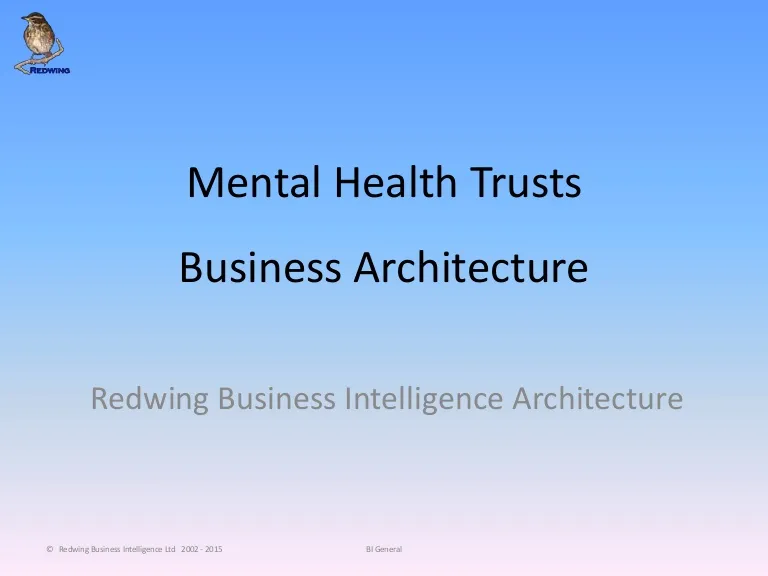Mental Health Business Architecture
Description
Mental health business architecture
Part of the Redwing Business Intelligence Architecture series
Transcript
© Redwing Business Intelligence Ltd 2002 - 2015 BI General
Mental Health Trusts
Business Architecture
Redwing Business Intelligence Architecture
Context
• 30% to 50% of Primary care workload is MH related
(especially depression).
• Seventy to eighty percent of young men in
prison/offenders have a MH condition.
• Patients with MH conditions who remain untreated
suffer a 15-25 years’ reduction in their life
expectancy and poorer quality of life.
• MH has the largest disease burden in the UK (22.8%)
compared to CVD (16.2%) and cancer (15.9%)
© Redwing Business Intelligence 2013 Architecture Slide 2
Source: King’s Fund
Architectural Framework
• Strategy: current and future activity
- and local intelligence
• Patients’ - and carers’ - experiences and outcomes
• Clinical quality: in particular, clinical outcome
• Access / targets / KPIs
• Finance: including income/expenditure and cash flow
• Efficiency: including discharges and use of resources
• Workforce: including workforce planning, violent
incidents and satisfaction
© Redwing Business Intelligence 2013 Architecture Slide 3
Architectural Layers
© Redwing Business Intelligence 2013 Architecture Slide 4
Technology (Specific Product)
Technology (Hardware, Networks, Infrastructure)
Application (Systems, Components, Services)
Data (Business Entities, Databases, Schemas)
Information System (Data and Application)
Business (Strategy, Priorities, Organisation)
Architectural Overview
© Redwing Business Intelligence 2013 Architecture Slide 5
Board-defined Vision, Strategy, Goals, Objectives Board Governance: Monitoring, Tracking, Adjusting
Accessibility
Referral
Protocols
Available
Services
Patient
Crisis?
Comprehensive?
Specific?
Simple?
Action Plan
Initial Presentation
Assessment
Care Plan
Care Coordination?
Coordinated Care
Delivery of Care
Evaluation
Multiple Patient-Centric Integrated Care Pathways
Patient Administration System Business Intelligence System
Database
Operational
Reports
The Data WarehouseThe Data Warehouse
Dashboards,
Scorecards,
etc.
Processes and Events
• Every enterprise has functional processes
• Each functional process generates events of interest
• For example, as part of the Assessment process, a
patient was admitted to a hospital as an in-patient
• That’s an event of interest to the enterprise
(a.k.a. a Fact).
• All Facts have data that can be analysed At the very
least, it can be counted.
• The data warehouse is an automatic spin-off
© Redwing Business Intelligence 2013 Architecture Slide 6
Example of PIs for a single area
• Engagement with partners e.g. social services,
general practice, housing, home office:
– Progress against joint strategic objectives
– % delayed discharges
– % delayed admission for people on section of the Mental Health Act
– % children in adult beds
– % admissions with length of stay of less than one week
– Out of area assessments and treatment
– Continuing care placements
– % stable patients seen in outpatient clinics (rather than primary care)
– Balance of prescribing between primary and secondary care for atypical antidepressants, ADHD
meds
– Readmissions
– 7-day follow ups
– Gateway workers
– Prison transfer waits
© Redwing Business Intelligence 2013 Architecture Slide 7
Process Improvement
• Processes to be end-to-end defined
• Ward staffing – as an example
• Here are the goals:
– Understand and predict staffing levels
– Plan rostering
– Manage use of bank and agency staff
– Create automated workflow for bureau (bank and
temporary staff) take-on . . . including training, know-the-
patient, and help systems
© Redwing Business Intelligence 2013 Architecture Slide 8
Quality and Performance
© Redwing Business Intelligence 2013 Architecture Slide 9
Safety and Safeguarding (1)
• Insufficient just to record incidents
• Insufficient to investigate single incidents in isolation
• Need to show patterns of unsafe behaviours
• Need to differentiate types of incidents
• Need to understand trends
• Crucial input to risk management
• Essential component of good governance
© Redwing Business Intelligence 2013 Architecture Slide 10
Safety and Safeguarding (2)
© Redwing Business Intelligence 2013 Architecture Slide 11
Architectural Actions
1.Understand the organisation
2.Review internal documentation
3.Identify key stakeholders
4.Meet key stakeholders
5.Identify current business systems
6.Identify organisational priorities – provision of information to ensure
good governance, and to ensure patient safety.
7.Define the current business strategy, governance, and organisation
8.Define the key business processes, including the events.
9.Define the required future state
10.Identify the steps required to move to the future state
1. in terms that make sense to the business, and
2. which can be then implemented technically.
© Redwing Business Intelligence 2013 Architecture Slide 12
Architectural Deliverables
• Definition of current state
– Business vision and strategy . . . including issues/challenges
– Governance
– Organisation
– Processes
• Articulation of future state
• Step change plan for the business, from here to
there
• Articulation of technical implementation – the next
layer down in the Enterprise Architecture
© Redwing Business Intelligence 2013 Architecture Slide 13
Technical Architecture Spin-Off
© Redwing Business Intelligence 2013 Architecture Slide 14
Summary
• Purpose of business architecture is to enable new
and improved business and information systems to
be put in place.
• Those systems must serve the Board’s vision
• And support monitoring and governance
• And always . . . first and foremost . . .
serve the patient above all else
© Redwing Business Intelligence 2013 Architecture Slide 15
Discussion
© Redwing Business Intelligence 2013 Architecture Slide 16
Donna Kelly
donna@redwing-bi.com
0(781) 380-0181
